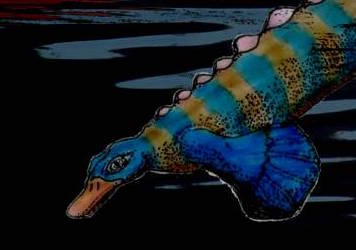
Strange marine animal from the Triassic had a platypus-like bill
The analysis of 250 million-year-old fossils has led to the discovery of a marine reptile that resembled a duck-billed platypus. Eretmorhipis carrolldongi existed in shallow seas during the Triassic period, and hunted for prey by relying on its sense of touch using a platypus-like bill.
In addition to having a cartilaginous bill, Eretmorhipis was about 70 centimeters in length with a rigid body, small head, and tiny eyes. The creature also had four flippers for swimming and steering, with bony plates along its back.
Study co-author Professor Ryosuke Motani is a paleontologist at the University of California, Davis. He explained that Eretmorhipis was previously known only from partial fossils without a head.
“This is a very strange animal,” said Professor Motani. “When I started thinking about the biology I was really puzzled.”
The two new fossils revealed that the animal’s skull had bones that would have supported a bill of cartilage. Just like the modern platypus, there is a large hole in the bones in the middle of the bill.
In the early Triassic, the region in China where the Eretmorhipis fossils were found was covered by a shallow sea that was around a meter deep. Underneath, a carbonate platform extended for hundreds of miles. The remains were recovered at what would have been deeper holes, or lagoons, in the platform.
While there are no fossils to show what Eretmorhipis ate, it likely fed on shrimp, worms, and other small invertebrates, according to Professor Motani. He said that the creature’s long, bony body likely meant that it was a poor swimmer. “It wouldn’t survive in the modern world, but it didn’t have any rivals at the time.”
The study is published in the journal Scientific Reports.
—
By Chrissy Sexton, Earth.com Staff Writer
Image Credit: Gianluca Danini














